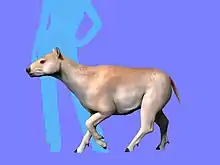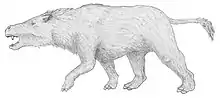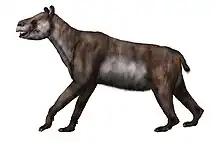Sparnotheriodontidae
Sparnotheriodontidae is an enigmatic extinct family of litopterns known primarily from teeth. Sparnotheriodontids are one of two South American native ungulate clades known to have reached Antarctica, the other being astrapotheres.
| Sparnotheriodontidae | |
|---|---|
| Scientific classification | |
| Domain: | Eukaryota |
| Kingdom: | Animalia |
| Phylum: | Chordata |
| Class: | Mammalia |
| Order: | †Litopterna |
| Family: | †Sparnotheriodontidae Soria, 1980 |
| Genera | |
| |
Description
Sparnotheriodontids ranged in size from the mid-sized Phoradiadus to the large Sparnotheriodon.[1] Sparnotheriodon and one species of Notiolofos, N. arquinotiensis, have been estimated to have had masses of roughly 400 kg (880 lb).[2] Another species of Notiolofos, N. regueroi, was smaller, with a body mass estimated to have been between 25 and 58 kg.[3]
Classification
The phylogenetic position of Sparnotheriodontidae is uncertain. Most researchers consider them to belong to Litopterna.[4][5] In contrast, Cifelli and Bergqvist have argued that sparnotheriodontids are condylarths.[6][7] Their methodology, based on attempting to associate isolated teeth and isolated postcranial bones based on size and relative abundance, has been criticized.[8] Phylogenetic analyses conducted by Chimento and Agnolin in 2020 and Kramarz et al. 2021 both included one sparnotheriodontid, Victorlemoinea, and found it to be a basal litoptern.[9][10] Unlike most authors, who treat sparnotheriodontids as a family, in 1997 McKenna and Bell classified them as a subfamily of Macraucheniidae.[11]
Genera
Sparnotheriodontidae contains the genera Victorlemoinea, Sparnotheriodon, Phoradiadus, and Notiolofos.[12][13] Victorlemoinea and Sparnotheriodon may be synonymous.[6] Soria regarded Heteroglyphis as a probable sparnotheriodontid,[14] but McKenna and Bell[15] and Bond et al.[16] included it in Anisolambdinae, with the former considering it a synonym of Protheosodon.
History of study
The first described sparnotheriodontid, Victorlemoinea, was named by Florentino Ameghino in 1901. In 1980, Miguel Soria named Sparnotheriodon and established the family Sparnotheriodontidae for it. He initially classified the family as belonging to Notoungulata. Sparnotheriodontids were first identified in Antarctica in 1990.[17]
Paleobiology, paleoecology, and paleobiogeography
Sparnotheriodontids lived in South America and Antarctica. Sparnotheriodontids and astrapotheres are the only clades of terrestrial placental mammals confirmed to have lived in Antarctica.[18] Sparnotheriodontids were browsing herbivores adapted to forest environments.[19] Their rarity in the fossil record suggests they were specialists.[20] Sparnotheriodontids may have been ecological equivalents to Meniscotherium, which is not closely related but had similar teeth.[21] Victorolemoinea lived during the Riochican and Itaboraian South American land mammal ages,[12] which date to the Ypresian age of the Eocene.[22] Notiolofos ranged from the early Eocene to the Rupelian age of the Oligocene.[23]
References
- Bond et al. 2006, p. 165.
- Gelfo 2016, p. 328.
- Gelfo, López & Santillana 2017, p. 454.
- Bergqvist 2008, p. 129.
- Gelfo 2016, p. 316.
- Cifelli 1983, p. 9.
- Bergqvist 2008.
- Gelfo 2016, p. 322.
- Chimento & Agnolín 2020, p. 2.
- Kramarz, Bond & MacPhee 2021, p. 6.
- McKenna & Bell 1997, p. 451.
- Bond et al. 2006, p. 163.
- Bond et al. 2009, p. 979.
- Soria 2001, p. 16.
- McKenna & Bell 1997, p. 454.
- Bond et al. 2006, p. 172.
- Gelfo 2016, p. 317.
- Gelfo et al. 2015, p. 101.
- Vizcaino et al. 1997, p. 349.
- Bond et al. 2006, p. 173.
- Gelfo 2016, p. 319.
- Woodburne et al. 2014, p. 112.
- Gelfo, López & Santillana 2017, p. 448.
Works cited
- Bergqvist, Lilian P. (2008). "Postcranial Skeleton of the Upper Paleocene (Itaboraian) "Condylarthra" (Mammalia) of Itaboraí Basin, Brazil". In Sargis, Eric J.; Dagosto, Marian (eds.). Mammalian Evolutionary Morphology. Vertebrate Paleobiology and Paleoanthropology Series. Dordrecht: Springer Netherlands. pp. 107–133. doi:10.1007/978-1-4020-6997-0_6. ISBN 978-1-4020-6996-3.
- Bond, M.; Reguero, M. A.; Vizcaíno, S. F.; Marenssi, S. A. (2006). "A new 'South American ungulate' (Mammalia: Litopterna) from the Eocene of the Antarctic Peninsula". Geological Society, London, Special Publications. 258 (1): 163–176. doi:10.1144/GSL.SP.2006.258.01.12. eISSN 2041-4927. ISSN 0305-8719. S2CID 140546667.
- Bond, Mariano; Reguero, Marcelo A.; Vizcaíno, Sergio F.; Marenssi, Sergio A.; Ortiz-Jaureguizar, Edgardo (2009-09-12). "Notiolofos, a replacement name for Notolophus Bond, Reguero, Vizcaíno, and Marenssi, 2006, a preoccupied name". Journal of Vertebrate Paleontology. 29 (3): 979. doi:10.1671/039.029.0321. eISSN 1937-2809. ISSN 0272-4634. S2CID 84808731.
- Chimento, Nicolás R.; Agnolín, Federico L. (2020-08-06). "Phylogenetic tree of Litopterna and Perissodactyla indicates a complex early history of hoofed mammals". Scientific Reports. 10 (1). doi:10.1038/s41598-020-70287-5. ISSN 2045-2322. PMID 32764723. S2CID 220981476.
- Cifelli, Richard L (1983-11-09). "The Origin and Affinities of the South American Condylarthra and Early Tertiary Litopterna (Mammalia)". American Museum Novitates (2772): 1–49.
- Gelfo, Javier N. (2016). "Considerations about the Evolutionary Stasis of Notiolofos arquinotiensis (Mammalia: Sparnotheriodontidae), Eocene of Seymour Island, Antarctica". Ameghiniana. 53 (3): 316–332. doi:10.5710/AMGH.14.09.2015.2934. eISSN 1851-8044. ISSN 0002-7014. S2CID 129877349.
- Gelfo, Javier N.; López, Guillermo M.; Santillana, Sergio N. (2017). "Eocene ungulate mammals from West Antarctica: implications from their fossil record and a new species". Antarctic Science. 29 (5): 445–455. doi:10.1017/S0954102017000244. eISSN 1365-2079. ISSN 0954-1020. S2CID 86868504.
- Gelfo, Javier N.; Mörs, Thomas; Lorente, Malena; López, Guillermo M.; Reguero, Marcelo (2015). "The oldest mammals from Antarctica, early Eocene of the La Meseta Formation, Seymour Island". Palaeontology. 58 (1): 101–110. doi:10.1111/pala.12121. eISSN 1475-4983. ISSN 0031-0239. S2CID 140177511.
- Kramarz, Alejandro G.; Bond, Mariano; MacPhee, Ross D. E. (2021-07-04). "On the alleged perissodactyl affinities of the "condylarth" Escribania chubutensis and other endemic South American ungulate-like placentals". Journal of Vertebrate Paleontology. 41 (4). doi:10.1080/02724634.2021.1986716. eISSN 1937-2809. ISSN 0272-4634. S2CID 244055434.
- McKenna, Malcolm C.; Bell, Susan K. (1997-10-17). Classification of Mammals: Above the Species Level. Columbia University Press. ISBN 978-0-231-52853-5.
- Soria, Miguel F. (2001). "Los Proterotheriidae (Litopterna, Mammalia), sistemática, origen y filogenia". Monografias del Museo Argentino de Ciencias Naturales (in Spanish). 1. ISSN 1515-7652.
- Vizcaino, S. F.; Bond, M.; Reguero, M. A.; Pascual, R. (1997). "The youngest record of fossil land mammals from Antarctica; its significance on the evolution of the terrestrial environment of the Antarctic peninsula during the late Eocene". Journal of Paleontology. 71 (2): 348–350. doi:10.1017/S0022336000039263. ISSN 0022-3360. S2CID 130521428.
- Woodburne, Michael O.; Goin, Francisco J.; Raigemborn, Maria Sol; Heizler, Matt; Gelfo, Javier N.; Oliveira, Edison V. (2014). "Revised timing of the South American early Paleogene land mammal ages". Journal of South American Earth Sciences. 54: 109–119. doi:10.1016/j.jsames.2014.05.003. ISSN 0895-9811.

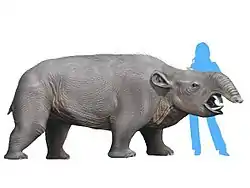
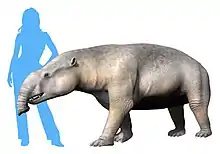
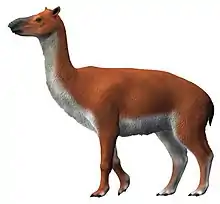
.jpg.webp)
